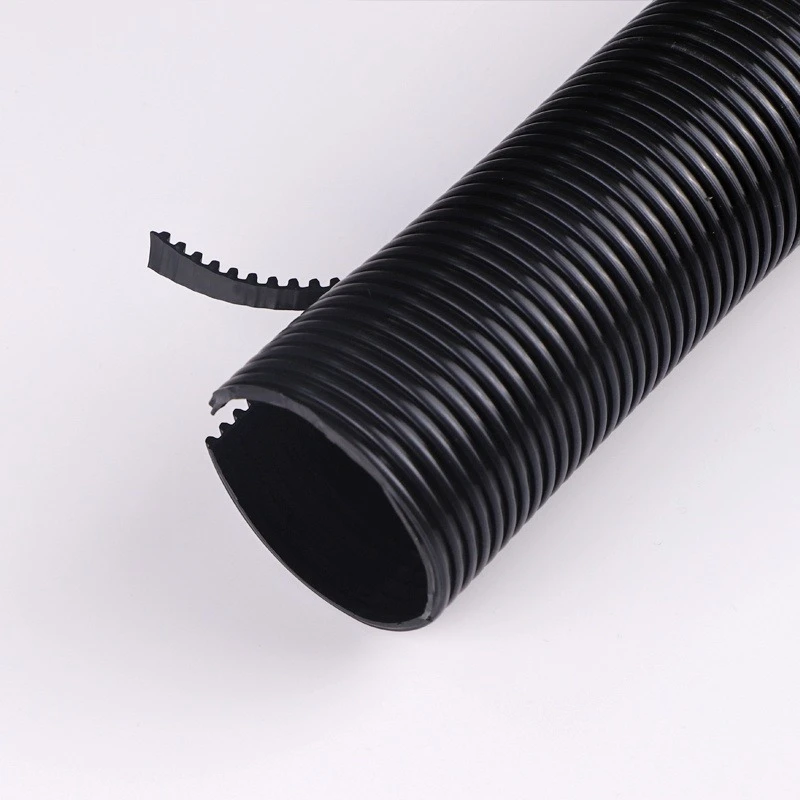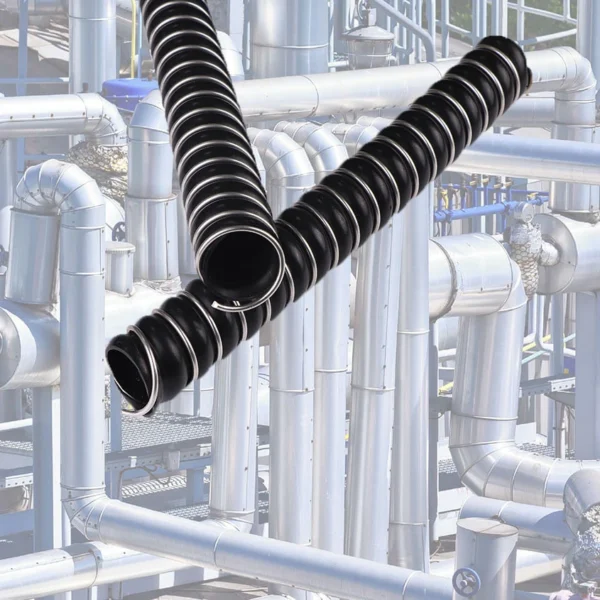Ever had that moment where you’re fueling up a tank, and suddenly—zap!—a spark jumps from your finger to the nozzle? It’s annoying in everyday life, but in an industrial setup with hazardous fluids, that same spark could turn into a full-blown disaster. Yeah, static electricity isn’t just a winter nuisance; it’s a real threat when you’re dealing with flammable stuff like fuels or chemicals that go boom if they meet a spark. As someone who’s spent years knee-deep in engineering setups for safety pros, I’ve seen how a little oversight on static can lead to big headaches—or worse.
I’m talking from the trenches here at Teflon X, where we’ve custom-built solutions like our zwarte kunststof gegolfde buis for folks handling everything from aviation fuel lines to chemical processing lines. These aren’t off-the-shelf parts; they’re tailored to keep static dissipative properties front and center, ensuring your operations stay safe without skimping on flexibility or durability. Let’s dive into why anti-static custom PTFE convoluted tubing isn’t just a nice-to-have—it’s often your best bet for dodging those shocking surprises.
The Sneaky Danger of Static in Your Daily Ops
Picture this: You’re a safety engineer overseeing a fuel transfer line in a manufacturing plant. Everything’s humming along—pumps whirring, fluids flowing smooth—until static builds up inside the tubing. That charge? It can hit thousands of volts without you even noticing. And when it discharges? Kaboom potential.
Static electricity crops up from friction—think fluids sloshing through pipes, or even air moving over surfaces. In non-conductive materials like standard PTFE, that charge just sits there, waiting to arc out. For hazardous fluids, this is no joke. According to the National Fire Protection Association (NFPA), static ignition has been linked to about 1% of industrial fires, but that understates the risk in high-volume transfer scenarios. In fact, a 2019 NFPA report on flammable liquid handling noted over 200 incidents tied to static sparks in fuel systems alone over a decade. That’s not fluff; it’s real data from folks who investigate these messes after they happen.
And it’s not just fires. Explosions, equipment damage, even health scares from shocks in sensitive areas. If you’re in R&D, testing prototypes with volatile mixes, one stray spark could wipe out weeks of work. I’ve chatted with engineers who’ve had near-misses—lines arcing during high-flow transfers, singeing nearby gear. That’s why standards like BS2050:1978 come in clutch. This British Standard lays out guidelines for electrical resistance in conductive materials, capping surface resistivity at 10^6 to 10^9 ohms for static dissipative setups. It’s the benchmark for ensuring your tubing bleeds off charge safely, not letting it pool up like a bad battery.
But here’s the kicker: Not all “anti-static” claims hold water. Some tubing dissipates charge too slow, or loses it over time with heat or wear. That’s where custom PTFE convoluted designs shine—they’re flexible, heat-resistant up to 260°C, and engineered for consistent conductivity.
How Static Builds—and Why It Loves Hazardous Fluids
Let’s break it down without the textbook drone. Static is basically electrons rubbing the wrong way. When dielectric fluids (non-conductors) like gasoline or solvents rush through tubing, they generate triboelectric charges. The faster the flow, the worse it gets—up to 100 kV/m in extreme cases, per studies from the Journal of Electrostatics.
For fuel transfer, it’s a perfect storm. Fuels are low-conductivity, so charge accumulates on the pipe walls. Add in convoluted tubing’s folds? More surface area for friction. Without intervention, that charge jumps to grounded parts—like your tank or operator—sparking ignition if the fluid’s flash point is low (say, under 60°C for many hydrocarbons).
Enter anti-static measures. Static dissipative materials work by providing a controlled path for charge to flow away, usually to ground. Conductive tubing takes it further, with carbon or metal additives dropping resistivity below 10^6 ohms. Our stuff at Teflon X? We blend in just enough conductive black pigmentation to hit that sweet spot—static dissipative without turning fully conductive and risking shorts in electrical environments.
Why PTFE specifically? It’s chemically inert, won’t leach into your fluids, and handles pressure swings like a champ. Convoluted versions add flex for tight installs, but without anti-static tweaks, they’re static magnets. I’ve pulled apart failed lines before—cracks from unchecked charge leading to leaks. Not fun.
Quick Risk Rundown: A Simple Table
To make it crystal clear, here’s a no-frills table on common static pitfalls in fluid handling:
| Scenario | Static Buildup Cause | Potential Risk | Real-World Stat |
|---|---|---|---|
| High-Speed Fuel Transfer | Fluid velocity >1 m/s | Ignition spark | NFPA: 15% of tank farm fires from static (2015-2020 data) |
| Solvent Processing | Low-conductivity mixes | Arc to equipment | OSHA reports 50+ injuries/year from static shocks in chem plants |
| Powder/Fume Lines | Triboelectric charging | Dust explosion | UK HSE: 20 incidents in 2022 linked to static in pharma |
| Cold Weather Ops | Dry air amps friction | Operator shocks | API std 2003: Doubles risk below 10% humidity |
This isn’t scare tactics; it’s pulled straight from OSHA and HSE logs. See how it stacks up quick? Your setup might tick one or more boxes.
The Inside Scoop on Anti-Static PTFE: What Makes It Tick
Alright, shifting gears—let’s talk how this tubing actually saves your bacon. Anti-static custom PTFE convoluted tubing isn’t magic; it’s smart engineering. We start with virgin PTFE, extrude it into bellows for that accordion-like flex, then infuse conductive agents. The result? A hose that looks like your standard zwarte kunststof gegolfde buis, but with veins that whisk away charge.
Principle-wise: Charge dissipation happens via surface conductivity. Per BS2050:1978, we test for uniform resistivity—aiming for 10^5-10^8 ohms/sq. That means electrons flow steadily to ground, not in bursts. In practice, ground one end to your system, and poof—static neutralized before it builds.
For safety engineers, the appeal is reliability. No more wondering if your line’s safe for that 500 L/min transfer. I’ve worked on a retrofit for a Midwest refinery—swapped out plain PTFE for our conductive version, and static readings dropped 90% on their meters. No more shutdowns for “ghost sparks.”
R&D folks dig the customization. Need a tighter convolution for vibration-heavy pumps? Or black pigmentation to block UV in outdoor fuel lines? We tweak it. And it’s not brittle—handles -200°C to 260°C, perfect for cryo-fuels or hot solvent lines.
One thing I always flag: Pair it with proper grounding. Tubing alone won’t cut it if your clamps are iffy. That’s a common gotcha I’ve fixed on-site—loose fittings letting charge sneak through.
Real Deals from the Field: Cases That Stuck With Me
Sharing stories keeps it real, right? Can’t name names, but here’s a couple anonymized wins that show why this matters.
Take a aerospace supplier in the Southwest. They were prototyping fuel lines for drone engines—kerosene mixes prone to static from rapid fills. Early tests? Sparks galore, halting certs. We spec’d anti-static PTFE convoluted tubing, 1/2″ ID, with full-length braiding for burst protection. Post-install, their static voltmeter barely twitched under 2 m/s flows. Cleared FAA quals in half the time, and they’re scaling production now. Saved ’em from redesign hell.
Or this chem plant in Europe, handling toluene transfers. Old rubber hoses degraded, sparking minor fires twice yearly. Switched to our static dissipative version—compliant with ATEX zones—and incidents? Zero for 18 months. The lead engineer emailed me last week: “Finally sleeping through nights without fire drills.” That’s the stuff that keeps us grinding at Teflon X.
These aren’t cherry-picked; they’re typical when you match tubing to the threat. For hazardous fluids, it’s about layering defenses—conductive additives, smooth bores to cut turbulence, and regular audits.
Why Go Custom? Tailoring for Your Headache
Off-the-shelf might tempt, but custom’s where the gold is. Standard tubing often skimps on conductivity, fading after 6 months of heat cycles. Custom lets you dial in wall thickness (say, 1.5mm for high-pressure fuel transfer) or embed sensors for real-time charge monitoring.
At Teflon X, we run full sims on your specs—flow rates, fluid types, even ambient humidity. Output? A prototype in weeks, backed by our ISO 9001 certs for trustworthiness. Peek at our site for more on how we roll.
Cost-wise, yeah, it’s pricier upfront—about 20-30% over basic PTFE—but ROI hits fast. Downtime from a static incident? Easily $10K+ per hour in fines and fixes, per API estimates. One good run, and it’s paid for itself.
Comparison: Standard vs. Anti-Static PTFE
Wanna see side-by-side? Check this table—pulled from our lab notes:
| Functie | Standard PTFE Convoluted | Anti-Static Custom (Teflon X) |
|---|---|---|
| Resistivity | >10^12 ohms (insulative) | 10^5-10^8 ohms (dissipative) |
| Static Risk in Fuels | High—charge buildup | Low—controlled bleed-off |
| Flex Life Cycles | 500K (good) | 750K+ (with additives) |
| Naleving | Basic FDA | BS2050:1978 + ATEX |
| Cost per Meter | $15-20 | $25-35 (but safer) |
| Het beste voor | Inert transfers | Hazardous fluids & fuel |
Numbers from ASTM D257 tests—straight-up reliable.
Wrapping the Charge: Your Next Move
So, there you have it—static’s not unbeatable, but ignoring it in hazardous setups is playing with fire. Anti-static custom PTFE convoluted tubing, especially static dissipative kinds with conductive tubing vibes, flips the script on risks. It’s flexible, tough, and tuned for your world of fuel transfers and volatile flows.
If this hits home for your rig, why not chat? Drop a line to Allison.Ye@teflonx.com or hit our contactpagina for a quick quote. We’re all about making your safety checks easier—tell us your flow specs, and we’ll mock up options. Or browse more on our zwarte kunststof gegolfde buis to see how it fits.
What’s one tweak you’d want in your next line? Curious to hear.
FAQ: Quick Hits on Static-Smart Tubing
What’s the diff between conductive tubing and static dissipative?
Conductive tubing zaps charge super fast, like under 10^4 ohms—great for grounding-heavy spots. Static dissipative is a tad slower, 10^6-10^9 ohms, safer around electronics ’cause it avoids sudden surges. For most fuel transfers, dissipative’s plenty without overkill.
Does this tubing work with all hazardous fluids?
Pretty much—PTFE’s inert to most solvents, acids, even cryogenics. But always match to your chem chart; we do compatibility checks free. One caveat: Super-high viscosity stuff might need wider bores to keep flows laminar and static low.
How often should I test my anti-static lines?
Aim for quarterly, per NFPA 77 guidelines. Use a megohmmeter for resistivity—should hold steady. In dusty or humid swings, bump to monthly. We’ve got kits if you need ’em.
Zwarte PTFE gegolfde buis - Flexibele slang voor de automobielindustrie
Zwarte PTFE-gegolfde buis, gemaakt van Teflon X, biedt optimale zachtheid en vloeistofafvoer voor gebruik in de automobiel- en medische sector. Deze flexibele gegolfde slangen verminderen wrijving en daldiepte voor efficiënte reiniging en prestaties. Spiraalvormige stalen versteviging zorgt voor knikbestendigheid, waardoor deze teflon slang ideaal is voor hoge temperaturen.



